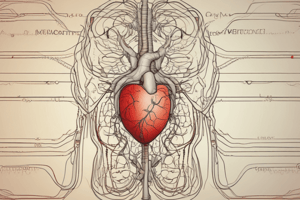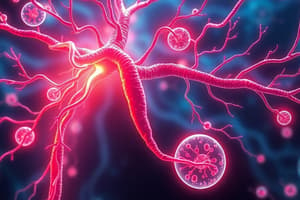Podcast
Questions and Answers
Which of the following is a primary function of the autonomic nervous system?
Which of the following is a primary function of the autonomic nervous system?
- Planning and execution of complex motor skills
- Regulation of voluntary muscle movement
- Conscious perception of sensory stimuli
- Regulation of heart rate and force of contraction (correct)
In the sympathetic nervous system, norepinephrine (NE) is released from which of the following?
In the sympathetic nervous system, norepinephrine (NE) is released from which of the following?
- Motor neurons
- Postganglionic sympathetic fibers (correct)
- Sensory neurons
- Preganglionic parasympathetic fibers
Which of the following receptors is primarily located on the heart and kidneys and, when stimulated, increases heart rate and renin secretion?
Which of the following receptors is primarily located on the heart and kidneys and, when stimulated, increases heart rate and renin secretion?
- Beta 2
- Beta 1 (correct)
- Alpha 2
- Alpha 1
Epinephrine can cause both vasodilation and vasoconstriction depending on the dose. Which of the following explains this biphasic response?
Epinephrine can cause both vasodilation and vasoconstriction depending on the dose. Which of the following explains this biphasic response?
Norepinephrine is used as a vasopressor agent, especially in cases of hypovolemic shock, because it primarily affects which receptors?
Norepinephrine is used as a vasopressor agent, especially in cases of hypovolemic shock, because it primarily affects which receptors?
Propranolol, a non-selective beta blocker, reduces blood pressure. Which mechanism contributes to this effect?
Propranolol, a non-selective beta blocker, reduces blood pressure. Which mechanism contributes to this effect?
Acetylcholine (ACh) primarily mediates its effects in the parasympathetic nervous system by acting on which type of receptors?
Acetylcholine (ACh) primarily mediates its effects in the parasympathetic nervous system by acting on which type of receptors?
In ophthalmic surgery, acetylcholine is used as a miotic to constrict the pupil. How is acetylcholine administered in this scenario?
In ophthalmic surgery, acetylcholine is used as a miotic to constrict the pupil. How is acetylcholine administered in this scenario?
Why does acetylcholine have limited clinical application despite its function as a significant neurotransmitter?
Why does acetylcholine have limited clinical application despite its function as a significant neurotransmitter?
In a patient experiencing sinus bradycardia, which drug might be administered to increase heart rate by blocking the effects of the vagal nerve on the heart?
In a patient experiencing sinus bradycardia, which drug might be administered to increase heart rate by blocking the effects of the vagal nerve on the heart?
Flashcards
Autonomic Nervous System
Autonomic Nervous System
The division of the peripheral nervous system that controls involuntary functions, including heart rate and digestion.
Sympathetic Nervous System
Sympathetic Nervous System
The sympathetic nervous system prepares the body for 'fight or flight' responses.
Parasympathetic Nervous System
Parasympathetic Nervous System
The parasympathetic nervous system promotes 'rest and digest' functions.
Epinephrine (Adrenaline)
Epinephrine (Adrenaline)
Signup and view all the flashcards
Norepinephrine (Noradrenaline)
Norepinephrine (Noradrenaline)
Signup and view all the flashcards
Propranolol
Propranolol
Signup and view all the flashcards
Acetylcholine (ACh)
Acetylcholine (ACh)
Signup and view all the flashcards
M₂ Receptors Location
M₂ Receptors Location
Signup and view all the flashcards
Atropine
Atropine
Signup and view all the flashcards
M₃ Receptors
M₃ Receptors
Signup and view all the flashcards
Study Notes
Autonomic Drugs Objectives
- The sympathetic nervous system controls heart rate and blood pressure
- The parasympathetic nervous system controls heart rate and blood pressure
Autonomic Nervous System
- Cardiac output is CO
- Blood pressure is BP
- Stroke volume is SV
Autonomic Nervous System Functions
- Regulates heart rate and contraction force
- Constricts and dilates blood vessels
- Contracts and relaxes smooth muscle in various organs
- Supports Visual accommodation, controls pupillary size, regulates secretions from exocrine and endocrine glands
Sympathetic Nervous System
- Facilitates fight, fright, or flight responses
- Facilitates arousal responses
- Releases neurotransmitters like norepinephrine from postganglionic sympathetic fibers
- Releases neurotransmitters like epinephrine (E) from the adrenal medulla
Sympathetic Nervous System Receptors
- a₁ receptors are found on blood vessels, smooth muscles, bronchi, GIT, uterus, bladder, and iris
- a2 receptors are primarily on the GIT, pancreas, and minimally on blood vessels
- β1 receptors mainly affect the heart, kidneys, and salivary glands
- β2 receptors are on blood vessels, bronchi, GIT, uterus, bladder, iris, and ciliary muscle
Adrenergic Agonists: Epinephrine/Adrenaline
- Epinephrine is a non-selective adrenergic agonist, affecting both α and β receptors
Epinephrine/Adrenaline CVS Effects
- Increases heart rate (HR) and contraction force through β1 receptors
- Affects blood pressure with a biphasic response
Epinephrine Low Dose Effects
- Vasodilation occurs through β2 receptors, decreasing blood pressure and causing a reflex increase in heart rate
- Reflex increase in heart rate, plus stimulation of the heart via β1 receptors, can significantly raise heart rate and cardiac output, leading to a potent increase in blood pressure
Epinephrine High Dose Effects
- Vasoconstriction occurs through α1 receptors, increasing blood pressure and causing a reflex decrease in heart rate
- The reflex decrease in heart rate, combined with direct heart stimulation via β1 receptors, results in a net increase in heart rate, increasing cardiac output and potently increasing blood pressure
- The increase in blood pressure due to α1 receptors overshadows any fall in blood pressure from β2 receptors
Epinephrine Other Effects
- Relaxes bronchial muscles via β2 receptors
- Relaxes smooth muscles via β2 receptors and constricts sphincters via α1 receptors in the GIT
- Relaxes the pregnant uterus via β2 receptors
- Relaxes bladder smooth muscle via β2 receptors
- Contracts sphincter via α1 causing urinary retention
- Contraction of iris radial muscle triggers pupil dilation (mydriasis) via β2 receptors
- Decrease in insulin, increase in glycogenolysis (β2) causes hyperglycemia
Epinephrine, Clinical Uses & Adverse Effects
- Is used to treat cardiac arrest, nasal congestion, and acute asthma and to reverse low blood pressure in anaphylactic shock
- Can adverse effects such as cardiac arrhythmias, cerebral hemorrhage, headaches, anxiety, tremors, and palpitations
Epinephrine/Adrenaline Administration
- Ineffective when taken orally
- Slowly absorbed from subcutaneous tissue
- Absorbed faster from intramuscular sites
- Effective via inhalation locally, but not usually given intravenously due to rapid liver inactivation
- Rapidly inactivated in the liver by Monoamine Oxidase (MAO) and Catechol-o-methyl-transferase (COMT)
Norepinephrine/Noradrenaline
- Non-selective adrenergic agonist, targets alpha and beta-1 receptors
- Is an endogenous neurotransmitter
- Produces similar effects to epinephrine, affecting alpha receptors on blood vessels
- Acts on β1 receptors but has insignificant effects on β2 receptors
- Is unlikely to cause vasodilation
Norepinephrine/Noradrenaline Cardiovascular
- Vasoconstriction is facilitated by (α₁) increasing BP and triggering a reflex decrease in HR
- There is a reflex decrease in HR combined with direct heart stimulation (β₁) resulting in a net increase in HR which increases CO and increases BP
- Vasoconstriction increasesTPR as well as stroke volume resulting in increased systolic and diastolic BP and increased mean and pulse pressure
Norepinephrine/Noradrenaline Other Effects, Uses and Administration
- Increase coronary blood flow
- Hyperglycemia effect occurs at large doses
- Contraction in pregnant uterus
- Used vasopressor agent for hypovolemic shock and other hypotensive states administered with Noradrenal bitartrate via slow IV infusion at 2-4 mg/minute
Norepinephrine/Noradrenaline, Pharmacokinetics & Side Effects
- Poor absorption with ineffective oral and subcutaneous administration
- Administered intravenously
- Metabolized by MAO and COMT resulting in short duration of action
- Can cause anxiety, palpitation and respiratory difficulty
- Can cause headaches
- Extravasation causes necrosis, gangrene, severe hypertension, anginal pain
Propranolol
- Non-selective β antagonist (beta blocker)
Propranolol Cardio Vascular Effects
- Decreases heart rate, is less pronounced at resting heart rate
- Reduces coronary blood flow and oxygen consumption
- Reduces renin secretion from juxtaglomerular cells in the kidneys and the renin-angiotensin pathway that increases BP
Propranolol Uses & Adverse Effects
- Used to treat hypertension, prevent myocardial infarction, angina pectoris, arrhythmias, migraines, and stage fright
- Can induce heart failure, fatigue, depression, hypoglycemia especially for patients on insulin, and Bradycardia
Parasympathetic Nervous System
- Releases Acetylcholine (ACh) as a neurotransmitter
- Controls restorative, vegetative, and housing responses known as the rest and digest system
Parasympathetic Nervous System Receptors
- Includes both Muscarinic (M) and Nicotinic (N) receptors
- M1 receptor is mainly located in autonomic ganglia in the CNS and on presynaptic nerves for the ANS system
- M2 receptor is mainly located on the heart in nodes, GIT and the CNS system
- M3 receptor is located on glands, vasculature and smooth muscles
- Nicotinic receptors are in autonomic ganglia, NMJ for skeletal muscles, and the CNS
Muscarinic Receptor Subtypes
- M1 (Neural): Modulates neurotransmission
- M1 and M3 have activation coupled to a Gq protein to stimulate PLC, then increasing IP3 and DAG from membrane phospholipids thus increasing Ca2+
- M2 (Cardiac): Decreases heart rate and conduction.
- Activation coupled with Gai protein inhibiting adenylate cyclase, thus decreasing CAMP or increasing K+ efflux
- M3 (Muscular): Stimulates glandular secretion, contracts smooth muscles, and dilates blood vessels
- M3 (on blood vessels) results in activation that increases nitric oxide which activates guanylate cyclase, increasing cGMP
Parasympathetic Regulations of the Heart
- Utilizes Vagus nerves for the parasympathetic innervation of the heart
- Innervates the SA node, AV node, and atrial myocardium
- Employs acetylcholine (Ach) as the parasympathetic neurotransmitter
- Features M2 muscarinic receptors as the primary cholinergic receptors
Parasympathetic Activity Effects
- Does not contribute to or control the tone of blood vessels with M3 receptors presented on vessels
- M3 receptors affects vasculature that responds to circulating Ach and/or injected M3 agonists resulting in vasodilation and reduced BP
- Vascular effects associated with M3 agonists are not clinically exploited, but occur during drugs used for other purposes
Cholinergic Agonist: Acetylcholine (ACh)
- Non-selective Muscarinic & Nicotinic agonist
Acetylcholine (ACh) Cardio Vascular Effects
- Decrease in heart rate and force of cardiac contraction of the heart through M2 receptor
- Vasodilation is facilitated via a NO pathway on vascular endothelium which decreases BP through M3 receptors
Acetylcholine (ACh) Other Effects and Pharmacokinetics
- Includes increased contraction of smooth muscles, increased motility in GIT and secretion activity
- Other effects are increased uterine activity, bronchial tone as well as increased contractility of bladder
- Contraction of pupil and constriction of ciliary muscles
- Effects involve salivary, sweat and lacrimal gland stimulation
- Rapidly hydrolyzed by cholinesterase with short duration of action
- Effects are also non-specific due to targeting M and N receptors due to clinical application
Cholinergic Antagonist: Atropine
- Is a Non-selective muscarinic antagonist
- Competitively inhibits the actions of ACh at muscarinic receptor sites M2 & M3
Atropine - Cardio Vascular Effects
- Blocks vagal nerve effects to the heart at M2 causing increased HR and increased conduction
- If given intravenously it causes initial transient bradycardia at low dose.
Atropine - Other Effects
- Includes Relaxation of smooth muscles
- Includes of bronchial muscles and decreasing secretions
- Reduction in motility of GIT
- Relaxation of smooth muscle in bladder
- Relaxation of ciliary muscle causing cycloplegia
- Relaxation of sphincter pupillae causing mydriasis
- Decrease in salivary, gastric and sweat gland secretion
Atropine- Therapeutic Use & Adverse Effects
- Used for Sinus bradycardia and heart block
- Opthamology and Pre-operative medication to decrease secretions
- Used as a Prophylaxis of motion sickness
- Includes tachycardia constipation, blurry vision, dry mouth and urine retention
Studying That Suits You
Use AI to generate personalized quizzes and flashcards to suit your learning preferences.



